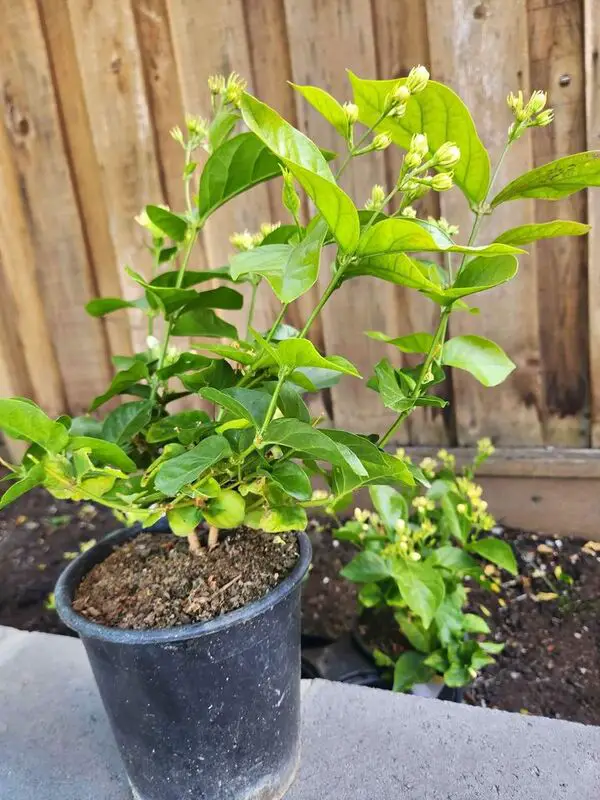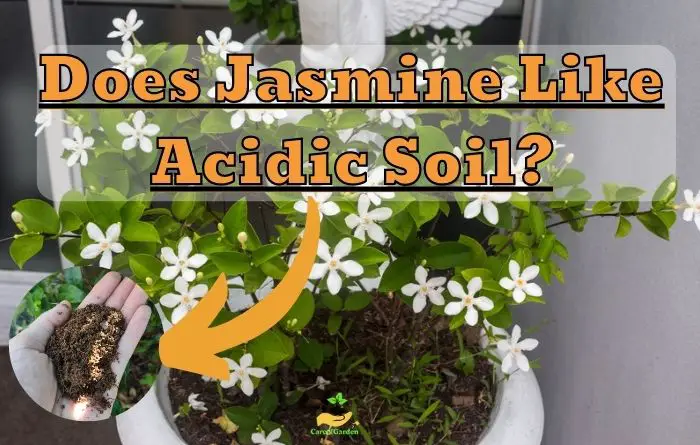Does Jasmine Like Acidic Soil? (Here Is The Answer)
If you’re planning to grow jasmine plants in your garden or home, you may be wondering what type of soil they prefer. While jasmine plants can tolerate a range of soil conditions, they do have specific preferences when it comes to soil acidity. One question remains to be answered: Does Jasmine Like Acidic Soil?
Jasmine plants prefer slightly acidic soil conditions, with a pH range of 6.0 to 7.5. Well-drained sandy loam or loamy soil textures are recommended. Adding organic matter or using acidifying fertilizers can help adjust the pH for optimal growth. If your soil is outside the ideal pH range for jasmine plants, you can adjust it using methods such as adding lime to increase soil pH or sulfur to decrease soil pH.
In this blog post, let’s meticulously investigate whether jasmine plants have an affinity for acidic soil and explore the ramifications it holds for their health and growth.
Soil Preferences of Jasmine Plants
Jasmine plants, renowned for their entrancing fragrance and exquisite blooms, require a nurturing environment to thrive. One of the critical components of this environment is the soil in which they are planted.
Let’s dive into understanding the specific soil conditions, particularly the pH levels, that jasmine plants prefer and what makes these conditions ideal for them.
| Jasmine Soil Preference | Description |
|---|---|
| Soil Type | Well-drained soils are preferred by Jasmine plants. These soils allow excess water to drain away effectively. |
| Soil Texture | Sandy loam or loamy soil texture is ideal for Jasmine plants. These soil types provide good drainage and aeration. |
| Soil pH | Jasmine plants thrive in slightly acidic to neutral soil pH range of 6.0 to 7.5. |
| Organic Matter | Soil enriched with organic matter, such as compost or well-rotted manure, benefits Jasmine plants’ growth. |
| Moisture | Jasmine plants require moist but not waterlogged soil. Consistent watering is necessary to maintain soil moisture. |
| Soil Fertility | Moderately fertile soil with a good balance of nutrients supports healthy growth and blooming of Jasmine plants. |
| Soil Temperature | Jasmine plants prefer warm soil temperatures ranging between 60°F to 75°F (15°C to 24°C) for optimal growth. |
https://plants.ces.ncsu.edu/plants/jasminum/
Ideal Soil pH Range for Jasmine Plants
Jasmine plants are versatile, but they do exhibit preferences for soil pH. The optimal pH range for most jasmine varieties is slightly acidic to slightly alkaline, usually falling between 6.0 and 7.5.
Within this pH range, jasmine plants can efficiently absorb the essential nutrients they need for flourishing growth and abundant blooming.
Table showcasing the pH preferences of some common Jasmine species:
| Jasmine Species | pH Preference |
|---|---|
| Jasminum sambac | 6.0 – 7.5 |
| Jasminum officinale | 6.0 – 7.5 |
| Jasminum polyanthum | 6.0 – 7.5 |
| Jasminum grandiflorum | 6.0 – 7.5 |
| Jasminum nudiflorum | 6.0 – 7.5 |
| Jasminum mesnyi | 6.0 – 7.5 |
Reasons Behind Jasmine’s Soil Preferences
The fondness of jasmine plants for a pH range between 6.0 and 7.5 is rooted in the science of nutrient availability.
This pH range ensures that the soil contains nutrients in forms that are easily accessible to the plants. Essential nutrients like nitrogen, phosphorus, potassium, and several trace elements are abundantly available within this range.
Another underlying reason is microbial activity. Slightly acidic to neutral soils harbor a plethora of beneficial microorganisms. These microscopic allies assist in breaking down organic matter, facilitating the release of nutrients that the jasmine plants can absorb.
Additionally, the soil structure plays a significant role. Soils within the preferred pH range tend to have good structure, which is crucial for root growth and water infiltration.
Consequences of Planting Jasmine in Unsuitable Soil
When jasmine is planted in soils where the pH deviates significantly from the ideal range, various issues can arise. Highly acidic or highly alkaline soils can impede the jasmine’s ability to absorb nutrients.
Consequently, your jasmine plant may exhibit stunted growth, yellowing leaves, and diminished flower production. The weakened plant, struggling to grow in unsuitable soil, becomes more vulnerable to diseases and pest infestations.
Effects of Acidic Soil on Jasmine Plants

Even though jasmine plants are relatively adaptable, the acidity of the soil can greatly influence their health, growth, and performance.
Acidic soil can alter nutrient availability and even introduce harmful elements to the plant’s root system. In the following sections, we explore these impacts in greater detail.
Here is a table with symptoms of jasmine plants grown in soil that is too acidic or alkaline:
| Soil pH | Symptoms of Jasmine Plants |
|---|---|
| Too acidic (below 6.0) | 1.Leaf yellowing, stunted growth, reduced flower production, increased susceptibility to disease and pests. Nutrient deficiencies, especially iron and manganese. 2.Increased susceptibility to pests and diseases. |
| Too alkaline (above 7.5) | 1.Leaf yellowing, stunted growth, reduced flower production, nutrient deficiencies (such as iron and manganese), increased susceptibility to disease and pests. 2.Leaf curling or distortion. |
https://hgic.clemson.edu/factsheet/changing-the-ph-of-your-soil/
Impact on Growth, Health, and Performance
Acidic soil, particularly when the pH is below 6.0, can be detrimental to jasmine plants. The increased acidity affects the solubility of minerals. Although some nutrients become more soluble, others, like phosphorus, become less available.
Moreover, elements such as aluminum and manganese can reach toxic levels in very acidic soils. These toxicities can damage the plant’s root system and compromise its ability to absorb water and nutrients.
The culmination of these factors—reduced nutrient availability and potential toxicities—means poor growth, leaf yellowing, diminished flowering, and an overall deterioration in the plant’s health and vitality.
Symptoms of Nutrient Deficiencies or Toxicities in Acidic Soil
In excessively acidic soil, jasmine plants may exhibit symptoms indicating nutrient deficiencies or toxicities, which can affect their overall health and growth.
- Yellowing Leaves: When jasmine is in acidic soil, the leaves might turn yellow due to iron or magnesium deficiency, a condition known as chlorosis. In such cases, the plant struggles to produce chlorophyll, leading to the yellowing of the leaves while the veins may stay green.
- Stunted Growth and Reduced Flowering: Highly acidic soil can lead to phosphorus deficiency in jasmine plants. Phosphorus is vital for the plant’s energy transfer and storage, and its deficiency can result in stunted growth and decreased flower production, often accompanied by darkening foliage.
- Root Damage or Browning Leaf Tips: In acidic soils, aluminum, and manganese can reach toxic levels. This toxicity can damage the roots, preventing them from absorbing water and nutrients effectively. Consequently, jasmine plants may show browning leaf tips and wilting.
- Addressing the Issue: To address these issues, it’s essential to regularly test soil pH and make necessary amendments. Adding lime can reduce soil acidity, and using appropriate fertilizers can help in providing the required nutrients. Proper irrigation practices are also vital for maintaining jasmine plant health.
How to Test Soil Acidity for Jasmine Plants
Here are the steps to test the soil acidity for your jasmine:
1. Purchase a soil pH test kit or a pH meter.
You can purchase soil pH testing kits at most garden centers and hardware stores. These kits usually come with pH testing strips or a color indicator solution, which can provide quick and easy results.
2. Take Soil samples.
Collect soil samples for your jasmine root zones from a depth of about 4 to 6 inches (10 to 15 cm) using a clean gardening shovel. Make sure to take multiple soil samples from jasmine planting area to account for the difference in soil pH.
3. Prepare your soil sample for testing.
In order to get an accurate result, you need to prepare your soil sample by removing any debris, rocks, or plant material from it. The second thing you need to do is mix the collected soil samples, breaking up any clumps to make sure the soil mixture is even.
4. Test the soil acidity.
To use a soil pH testing kit, follow the instructions provided with the kit, which typically involve mixing soil with a testing solution and comparing the resulting color to a chart to determine the pH level.
Additionally, you can use a pH meter designed for testing soil acidity. As instructed by the manufacturer, insert the pH meter’s probe into the soil sample. A pH reading will be given by the meter.
5. Read the pH level and Interpret the results.
In the last step, if you’ve used a pH testing kit, you need to compare the color of the solution to a color chart provided by the kit. The color will correspond to the pH level. The pH scale ranges from 0 to 14, with pH 7 being neutral.
Jasmine plants generally prefer slightly acidic to neutral soil with a pH range of 6.0 to 7.5. If the pH falls outside this range, adjustments may be needed.
Methods to adjust and regulate soil pH for jasmine plants
Here are some methods to adjust and regulate soil pH for jasmine plants:
1.Add lime to boost soil pH if it is too acidic: Lime can assist raise the pH level of your soil if it is too acidic. It is best to get the soil analyzed before applying lime because the amount of lime required varies on the kind of soil. For soils with little magnesium, dolomitic lime is a viable option.
2.Add sulfur to your soil to lower pH: If your soil is overly alkaline, sulfur can help. The most effective form of sulfur for acidifying soil is elemental sulfur, but results can take many months to appear. Jasmine might be damaged by sulfur overapplication, so it’s crucial to adhere to the advised application rate.
3.Use acidifying fertilizers: Some fertilizers, such as ammonium sulfate and sulfur-coated urea, can help lower soil pH. These fertilizers should be used in moderation, as overuse can lead to nutrient imbalances and other problems.
4.Use compost: Adding compost to soil can help regulate pH levels over time. Compost can help increase soil acidity by releasing organic acids, and can also help increase soil alkalinity by releasing calcium and magnesium.
5.Use acidic mulches: Mulches such as pine needles, oak leaves, and sawdust can help lower soil pH over time. These mulches should be used in moderation, as overuse can lead to nutrient imbalances and other problems.
6.Planting in Raised Beds or Pots: If the native soil is extremely acidic, consider planting jasmine in raised beds or pots with a soil mix that meets the plant’s pH requirements.
7.Mulching: Laying a layer of organic mulch around jasmine plants aids in soil temperature regulation and moisture retention. Moreover, as the mulch decomposes, it can incrementally improve the soil pH.




